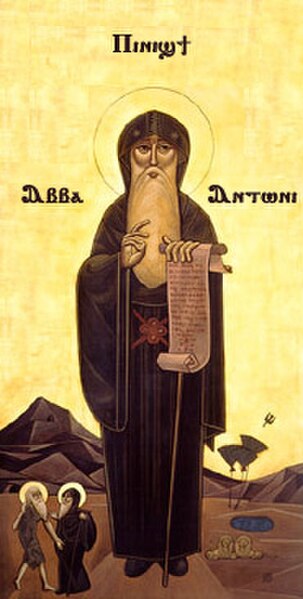Onuphrius lived as a hermit in the desert of Upper Egypt in the 4th or 5th centuries. He is venerated as Saint Onuphrius in both the Roman Catholic and Eastern Catholic churches, as Venerable Onuphrius in Eastern Orthodoxy, and as Saint Nofer the Anchorite in Oriental Orthodoxy.
Saint Onuphrius
Stone carving above the entrance of the St. Onuphrius Monastery in Akeldama, Jerusalem (Potter's field). The image shows Onuphrius bowing down to an angel. Notable features are his long beard and leaf loincloth.
Onuphrius depicted as a "wild man".
Battistello Caracciolo, Galleria Nazionale d'Arte Antica, Rome
The Desert Fathers were early Christian hermits and ascetics, who lived primarily in the Scetes desert of the Roman province of Egypt, beginning around the third century AD. The Apophthegmata Patrum is a collection of the wisdom of some of the early desert monks and nuns, in print as Sayings of the Desert Fathers. The first Desert Father was Paul of Thebes, and the most well known was Anthony the Great, who moved to the desert in AD 270–271 and became known as both the father and founder of desert monasticism. By the time Anthony had died in AD 356, thousands of monks and nuns had been drawn to living in the desert following Anthony's example, leading his biographer, Athanasius of Alexandria, to write that "the desert had become a city." The Desert Fathers had a major influence on the development of Christianity.
Coptic icon of Anthony the Great
"Saint Macarius and a Cherub" from Saint Catherine's Monastery, Sinai, Egypt
Icon of Pachomius
Icon of Arsenius the Great, notable Desert Father







